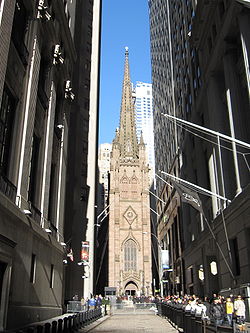 The Episcopal church known appropriately in all senses as Trinity Wall Street turns out to be worth a cool couple of billion dollars, according to an accounting of assets provided in response to a lawsuit. As reported in today’s New York Times, the assets are the residual legacy of a grant of 215 acres of farmland on Manhattan Island donated to the church by Queen Anne of England in 1705: “Since then, the church has parlayed that gift into a rich portfolio of office buildings, stock investments and, soon, mixed-use residential development.”
The Episcopal church known appropriately in all senses as Trinity Wall Street turns out to be worth a cool couple of billion dollars, according to an accounting of assets provided in response to a lawsuit. As reported in today’s New York Times, the assets are the residual legacy of a grant of 215 acres of farmland on Manhattan Island donated to the church by Queen Anne of England in 1705: “Since then, the church has parlayed that gift into a rich portfolio of office buildings, stock investments and, soon, mixed-use residential development.”
Income from the holdings in 2011 was $158 million, of which $120 million went into the church’s real estate business. Of the remaining $38 million, $6 million were spent on maintaining its own historic properties, $4 million on communications, and $2.5 million on its music program. Its philanthropic program totaled $3 million, or less than two percent.
The lawsuit was filed by one Jeremy C. Bates, a “disenchanted” parishioner who contends that the church hasn’t been “acting on its values.” Not so, said Susan V. Berresford, a member of the vestry who used to be president of the Ford Foundation (worth $10 billion or so). “Given the resources, I think they do exactly what they should be doing,” she said. “This, I think, is a first-class philanthropic operation and one that is using its resources very wisely.”
For my part, I think there’s no better way to reflect upon this troubled situation than by recalling a similar exchange between James Gordon Bennett, then editor of the New York Herald, and one Harriette Smith, who wrote the following letter to him on December 14, 1836:
Do not you think that the amount of money expended for Christmas Greens to dress up Churches with, could be better laid out? There are between twenty and thirty Episcopal Churches in the city, that pay from five to fifteen dollars each for evergreens. Now if this money were paid for fuel or clothing for the poor, how much relief it would give! If you get this done, you will be the poor man’s friend.
Bennett issued the following reply.
I doubt, my dear Miss Harriette, whether I can be a poor man’s friend in this case. The property of the Episcopal Church in this city is immense, and it will continue to be immense till the descendants of Anneka Jants get their own. [This refers to a contemporary lawsuit filed against Trinity Church on behalf of the descendants of a woman who in 1652 obtained a grant of 130 acres of Manhattan real state that included the property on which the church stands.] It is utterly impossible to get rid of the property, or to bring the revenue within the limits of law, unless we expend it in every way that can be devised.
The purchase of beautiful evergreens at the very highest prices, not only helps to get rid of this surplus revenue of the Chruch, but it also circulates money during the present pressure, and furnishes, besides, a very fine relief to the eye when you enter church, to say your matins or sing your vespers — Sancte Maria — or otherwise thank Heaven that the Court of Errors (blessed be their errors) have not yet decided against you. It is true, the poor might be much aided by a few hundred dollars, as suggested by kindly Harriette Smith, but Eliza, her sister, says that the poor are so much accustomed to hunger and want, that pinching is necessary for their health and spirit at this season of the year.
Be that as it may, I do love to see God’s holy churches look cheerful and evergreen Christmas as New Year’s days. It is a picture of the beauty and verdure of religion. If we might be permitted to imagine how the spirits of the just decorate Heaven on Christmas day, we would array its thrones, altars, columns of god and pyramids of alabaster, with the freshest and purest evergreens taken from the trees of Paradise, where they are spreading freshness and fragrance along the banks of the clear stream of Eden eastward. If Trinity Church, or St. Pauls, or St. Thomas, or all the other Saintly Churches in the Episcopal calendar, are not beautifully and elegantly decorated, we shall give them on of the severest paragraphs they ever had. They ought to rejoice, if for nothing else, that they are still enjoying the vast property of Anneke Jants, and that many of her children’s children are wandering pennyless around the Union as very useful examples to teach patience and resignation under misfortune and the law’s delay, as well as give a lively example of sagacity of churchmen in holding on to what they get with a miser’s grasp.
Let the best evergreens be got that Long Island can afford. The poor we have always with us — cheap and plenty. We must get rid of the church surplus in some way. It is as troublesome as Gen. Jackson’s. We must be religious, elegant, expensive, and even buy evergreens for Churches! Why not decorate every parlor in which company is received on New Year’s day with wreaths of evergreens? How beautiful a beautiful woman looks, surrounded with fragrant evergreens! Let it be done.
Take that, Mr. Bates!





